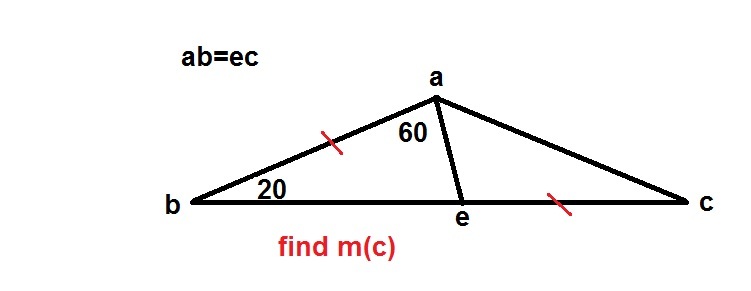This section requires Javascript.
You are seeing this because something didn't load right. We suggest you, (a) try
refreshing the page, (b) enabling javascript if it is disabled on your browser and,
finally, (c)
loading the
non-javascript version of this page
. We're sorry about the hassle.


Note: The figure is confusing because ∠ A E B = 1 0 0 ∘ , but it looks acute.
The sum of the angles in a triangle = 180, therefore angle BEA = 100; angle AEC is supplementary and therefore = 80. Let angle c = x, then angle EAC = 180 - 80 - x = 100 - x.
Since EC and AB are equal in length, 'move' triangle ACE on top of triangle AEB, by constructing point F such that △ F A B ≅ △ A C E .
Extend Notice that ∠ F B E = ∠ F B A + ∠ A B E = ∠ A E C + ∠ A B E = 1 0 0 ∘ , ∠ A E B = 1 0 0 ∘ . If we extend AE and BF to intersect at G, then E B G is an isosceles triangle with G B = G E since that have the same base angles 8 0 ∘ .
Notice that B F = A E by the congruent triangles, so G F = G A giving us another set of isosceles triangles. Hence 8 0 ∘ = ∠ B F A = ∠ E A C and so ∠ A C B = 1 8 0 ∘ − ∠ E A C − ∠ A E C = 1 8 0 ∘ − 8 0 ∘ − 8 0 ∘ = 2 0 ∘ .